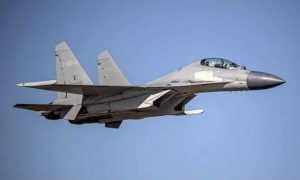Army says warships, anti-submarine aircraft and fighter planes sent to the south-west and south-east of island
 A Chinese PLA J-16 fighter jet. The country’s military activity towards Taiwan has increased over the past year. Photograph: AP
A Chinese PLA J-16 fighter jet. The country’s military activity towards Taiwan has increased over the past year. Photograph: AP
China has launched live-fire air and sea exercises near Taiwan in response to what it called “external interference and provocations by Taiwan independence forces”.
According to a statement from Col Shi Yi, the spokesperson of the People’s Liberation Army’s (PLA) Eastern Theatre Command, warships, anti-submarine aircraft and fighter planes were dispatched to the south-west and south-east of Taiwan on Tuesday.
In response, Taiwan’s defence ministry said: “The nation’s military has a full grasp and has made a full assessment of the situation in the Taiwan strait region, as well as related developments at sea and in the air, and is prepared for various responses.”
It follows more than a year of increasing Chinese military activity towards Taiwan, and after recent passages by US and European military vessels through and near contested areas of the South China Sea.
In past weeks Taiwan has also had another large weapon purchase order from the US approved, and had agreed to set up mutual diplomatic representative offices with Lithuania – the latter of which prompted Beijing to recall its ambassador from the European nation, and order Lithuania’s out of China.
The PLA, which is the military arm of the ruling Chinese Communist party, has drastically increased its air force sorties into Taiwan’s air defence identification zone (ADIZ). Taiwan’s ADIZ is not its sovereign airspace and overlaps with the ADIZ of multiple neighbouring countries including China, but the PLA flights, which have occurred on a near-daily basis since last year, trigger Taiwan’s air force to send up fighter jets in response.
The PLA missions have ranged from one surveillance aircraft to sending dozens of planes including bombers and fighter jets towards Taiwan, including occasionally past the southern tip and up the east coast.
In an analysis for the Canadian thinktank the Macdonald–Laurier Institute, the China expert J Michael Cole said the most alarming incidents were the few that involved the PLA fighters crossing the median line – a generally accepted midpoint in the Taiwan strait.
“Those were rightly regarded as the most serious incidents not because they violated Taiwan’s airspace (they did not), but rather because the aircraft’s vector of approach pointed directly towards Taiwan rather than into the west Pacific or the South China Sea, as was the case with penetrations of Taiwan’s ADIZ,” said Cole.
Cole told the Guardian exercises like Tuesday’s were often for psychological effect. “We’ve been seeing this every year, and often those are routine, small-scale exercises, their significance upped by state media and officials in order to send a signal.”
Taiwanese defence commentator, Wang Zhen Ming, said Taiwan was in some ways becoming numb to the frequent drills and incursions.
“This is good and bad … China’s military drills don’t really have an effect on Taiwan, but from the bad side, and this may also be the purpose of PLA, Taiwan can lower its guard with the frequency.”
Beijing claims Taiwan to be a province of China, which it must retake by force if necessary. Taiwan’s government says it is already an independent nation. Taiwan has never been ruled by the Chinese Communist party, but growing efforts by Beijing to push the archipelago’s population and government into unification has prompted increased international support for Taiwan, including from the US, Japan and other allies.
The PLA statement said the US and Taiwan had “repeatedly provoked and sent serious wrong signals, severely infringed upon China’s sovereignty, and severely undermined the peace and stability of the Taiwan strait, which has become the biggest source of security risks across the Taiwan strait”.
“This exercise … is a solemn response to external interference and provocations by Taiwan independence forces,” it said.
